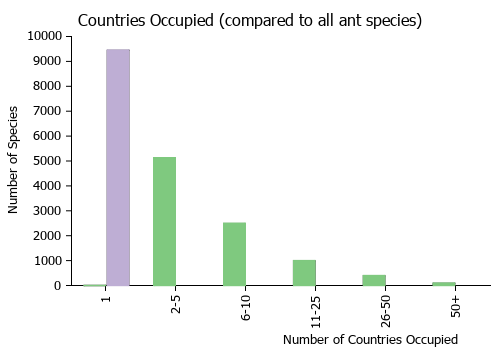Aphaenogaster irrigua
| Aphaenogaster irrigua | |
|---|---|
| Scientific classification | |
| Kingdom: | Animalia |
| Phylum: | Arthropoda |
| Class: | Insecta |
| Order: | Hymenoptera |
| Family: | Formicidae |
| Subfamily: | Myrmicinae |
| Tribe: | Attini |
| Genus: | Aphaenogaster |
| Species: | A. irrigua |
| Binomial name | |
| Aphaenogaster irrigua Watanabe & Yamane, 1999 | |
| Common Name | |
|---|---|
| Sawa-ashinaga-ari | |
| Language: | Japanese |
This species prefers moist situations; it nests in the soil in woodlands, near banks of streams and dry river beds. Foraging workers do not turn their gasters downwards (Japanese Ant Image Database).
Identification
Total length of workers around 4 - 6 mm. Head brown to light brown, mesosoma light brown, gaster dark brown to brown, legs light brown. Scapes, mesosoma and legs relatively rather long compared to other Japanese Aphaenogaster species. Anterior portion of clypeus with transverse striae. Basal margin of mandibles often weakly serrate. Mesonotum only weakly raised, predominantly covered with punctures. Similar to Aphaenogaster osimenseis, but separable by the presence of shallow, small punctures on the occiput and pronotal dorsum, and the dull surfaces of the propodeum and lateral parts of mesopleura, which are covered with striae and punctures. (Japanese Ant Image Database)
Distribution
Distribution based on Regional Taxon Lists
Palaearctic Region: Japan (type locality).
Distribution based on AntMaps
Distribution based on AntWeb specimens
Check data from AntWeb
Countries Occupied
| Number of countries occupied by this species based on AntWiki Regional Taxon Lists. In general, fewer countries occupied indicates a narrower range, while more countries indicates a more widespread species. |

|
Estimated Abundance
| Relative abundance based on number of AntMaps records per species (this species within the purple bar). Fewer records (to the left) indicates a less abundant/encountered species while more records (to the right) indicates more abundant/encountered species. |

|
Biology
Chromosome number 2n=32.
Castes
Nomenclature
The following information is derived from Barry Bolton's Online Catalogue of the Ants of the World.
- irrigua. Aphaenogaster irrigua Watanabe & Yamane, 1999: 734, fig. 18 (w.) JAPAN.
- Type-material: holotype worker, 73 paratype workers.
- Type-locality: holotype Japan: Ryukyu Is, Inokawa-dake, 27.v.1991 [colony 91072] (H. Watanabe); paratypes with same data.
- Type-depository: none stated (perhaps NIAS, OIST, SKYC, perhaps also KUIC, MNHA, UTKC).
- Status as species: Imai, et al. 2003: 178.
- Distribution: Japan.
Description
References
- Imai, H.T., Kihara, A., Kondoh, M., Kubota, M., Kuribayashi, S., Ogata, K., Onoyama, K., Taylor, R.W., Terayama, M., Yoshimura, M., Ugawa, Y. 2003. Ants of Japan. 224 pp, Gakken, Japan.
- Watanabe, H.; Yamane, S. 1999. New species and new status in the genus Aphaenogaster (Formicidae) in the Oriental and Australian regions. In: Identification Guide to the Aculeata of the Nansei Islands. Pp. 728-736 in: Yamane, S.; Ikudome, S.; Terayama, M (page 734, described)
References based on Global Ant Biodiversity Informatics
- Shimono A., and S. Yamane. 2003. Ant species diversity on Okinoerabu-jima, the Ryukyus, southern Japan. For the Establishment of Remote Islands Study (Kagoshima Univ.) 3: 11-29.
- Terayama M., S. Kubota, and K. Eguchi. 2014. Encyclopedia of Japanese ants. Asakura Shoten: Tokyo, 278 pp.
- Watanabe H., and S. Yamane. 1999. New species and new status in the genus Aphaenogaster (Formicidae) from Japan. Pp. 728-736 in: Yamane, S.; Ikudome, S.; Terayama, M. 1999. Identification guide to the Aculeata of the Nansei Islands, Japan. Sapporo: Hokkaido University Press, xii + 831 pp.
- Yamane S. 2016. How many species of Ants in Amami Islands? (in Japanese). Part 2, chapter 1 in How many species of Ants in Amami Islands? Pp. 92-132.
- Yamane S., S. Ikudome, and M. Terayama. 1999. Identification guide to the Aculeata of the Nansei Islands, Japan. Sapporo: Hokkaido University Press, xii + 831 pp. pp, 138-317.
- Yamane S., Y. Harada, and K. Eguchi. 2013. Classification and ecology of ants. Natural history of ants in Southern Kyushu. 200 pages
- Yamane S.; Ikudome, S.; Terayama, M. 1999. Identification guide to the Aculeata of the Nansei Islands, Japan. Sapporo: Hokkaido University Press, xii + 831 pp. pp138-317.